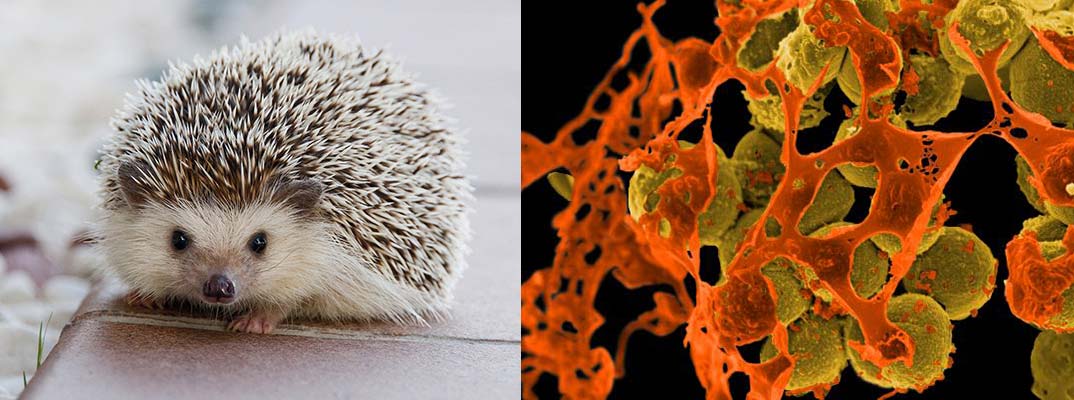The bacterium MRSA (shorthand for methicillin-resistant Staphylococcus aureus) resists several antibiotics and can cause super-charged staph infections, leading to difficult-to-treat skin infections, pneumonia, and sepsis. Antibiotic resistant bacteria like MRSA caused more than a million deaths in 2019. Now an international team of researchers has discovered what they think is the source of one variety of MRSA – and it didn’t come about through incremental evolution in people being treated with the antibiotic methicillin. It came from…hedgehogs.

Where's the evolution?
We’ve known that hedgehogs harbor antibiotic resistant bacteria since the 1960s. But the new research dug much deeper into this surprising observation. The research team got skin, nose, and foot swabs from hedgehogs across Europe and New Zealand. They found that northern European hedgehogs were very likely to carry these potentially deadly bacteria. Two different genes help S. aureus resist methicillin (mecC and mecA). The hedgehogs carried bacteria with the mecC gene.
The researchers got the genetic sequences of mecC-MRSA samples from hedgehogs, humans, and other animals and used these to build an evolutionary tree showing how all the MRSA samples are related to one another. They traced these different lineages back in time and found that some groups of the antibiotic resistant bacteria were infecting hedgehogs long before methicillin was even discovered, let alone prescribed to treat infections.
Evolutionary theory tells us that we should expect to see the rise of antibiotic resistant bacteria when antibiotics are used frequently. But then what was this superbug bacterium doing in wild animals that had never been treated with methicillin – and why did it have such a long history with them? The researchers hypothesize that the culprit is a fungus called Trichophyton erinacei, which often lives on the skin of hedgehogs. It also happens to produce its own antibiotics.
On hedgehog skin, this fungus competes with the staph bacterium for resources and real estate. The researchers think that this set the scene for an arms race between the fungus and the bacterium, with natural selection one-upping each side’s defenses and “weapons.” Each time the fungus evolved an advantage over the bacteria, it created an environment in which any bacterium that happened to be able to resist that new fungal weapon left behind more descendants – and vice versa. The weapons that the two sides wound up with through this arms race seem to be two antibiotics (on the fungal side) and the mecC antibiotic resistance gene (on the bacterial side).
So what does this mean? That there’s nothing we can do about antibiotic resistance? Certainly not. While mecC-MRSA didn’t arise because of overuse of methicillin, widespread use of this and related antibiotics allowed mecC- and other types of MRSA to flourish. Hedgehogs seem to have passed the resistant bacteria to dairy cows and other animals, and the bacteria eventually made their way to humans – already prepared for what was supposed to be one of our secret weapons: antibiotics.
The new research reminds us that evolution is powerful and unrelenting – and that we humans are not the only game in town. We should look to the natural world for new drugs, new tools, and new ideas because evolution’s slow, grand, tinkering experiment has produced innovations that we might never have dreamed up. But whatever powerful, disease-fighting weapons that we discover in nature, evolution has almost certainly been working on equally powerful defenses for millions or billions of years. By keeping this in mind and using tools like antibiotics thoughtfully, with both evolutionary history and their evolutionary future in mind, we can protect their utility.
The new research also shows us that human health is deeply intertwined with the health of other organisms that share the planet with us. The microbiome on a hedgehog’s skin, a chicken’s antibiotic-laced feed, or a bat’s virus is not isolated from the rest of the living world. Resistant bacteria and dangerous new viruses (as we now know all too well) can move from wild or domestic animals to humans and back again if given the opportunity. By recognizing these interconnections and planning for them, we help protect the health of humans, along with the rest of the living world.
Primary literature:
- Larsen, J., Raisen, C. L., Ba, X. Sadgrove, N. J., Padilla-González, G. F., Simmonds, M. S. J., … Larsen, A. R. (2022). Emergence of methicillin resistance predates the clinical use of antibiotics. Nature. https://doi.org/10.1038/s41586-021-04265-w Read it »
- Antimicrobial Resistance Collaborators. Global burden of bacterial antimicrobial resistance in 2019: A systematic analysis. The Lancet. https://doi.org/10.1016/S0140-6736(21)02724-0 Read it »
News articles:
- A friendly summary of the key findings from The New York Times
- A detailed examination of the new research from the Center for Infectious Disease Research and Policy
Understanding Evolution resources:
- In your own words, explain what happens during an evolutionary arms race. Be sure to include the concept of natural selection in your explanation.
- According to the article above, which two organisms do the researchers think have experienced an evolutionary arms race?
- How did our broad use of antibiotics like methicillin affect mecC-MRSA?
- Do some research online to find another example of an evolutionary arms race that does not involve bacteria and resistance to antibiotics. Describe that example.
- Zoonotic diseases are diseases that can spread from non-human animals to humans. Do some research online, and list three zoonotic diseases and what non-human animals they infect.
- Imagine that you read an article about this new research that states “bacteria develop resistance to avoid getting getting killed by antibiotic-producing microorganisms.” Review some common misconceptions about natural selection and then rewrite that sentence in a more accurate way.
- Teach about the evolution of antibiotic resistance. In this lesson for the high school and college levels, students learn why evolution is at the heart of a world health threat by investigating the increasing problem of antibiotic resistance in such menacing diseases as tuberculosis.
- Teach about managing antibiotic resistance. This research profile for the high school and college levels examines how the scientist Carl Bergstrom uses computer modeling to understand and control the evolution of antibiotic resistant bacteria in hospitals.
- Teach about arms races. In this case study for the high school and college levels, students learn about the rough-skinned newt, which has one of the most potent neurotoxins known to man. Find out how an evolutionary arms race has pushed these mild-mannered critters to the extremes of toxicity and how evolutionary biologists unraveled their fascinating story.
- Antimicrobial Resistance Collaborators. Global burden of bacterial antimicrobial resistance in 2019: A systematic analysis. The Lancet. https://doi.org/10.1016/S0140-6736(21)02724-0
- Larsen, J., Raisen, C. L., Ba, X. Sadgrove, N. J., Padilla-González, G. F., Simmonds, M. S. J., … Larsen, A. R. (2022). Emergence of methicillin resistance predates the clinical use of antibiotics. Nature. https://doi.org/10.1038/s41586-021-04265-w
- Nothias, L., Knight, R, and Dorrestein, P. C., (2016). Antibiotic discovery is a walk in the park. Proceedings of the National Academy of Sciences of the United States of America. 113: 14477-14479.
- Rasmussen, S. L., Larsen, J., van Wijk, R. E., Jones, O. R., Berg, T. B., Angen, Ø., and Larsen, A. R. (2019). European hedgehogs (Erinaceus europaeus) as a natural reservoir of methicillin-resistant Staphylococcus aureus carrying mecC in Denmark. PLoS One. https://doi.org/10.1371/journal.pone.0222031
